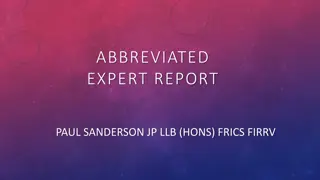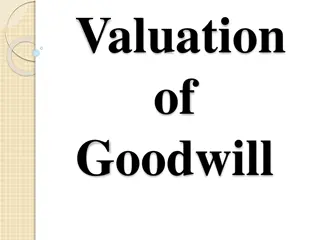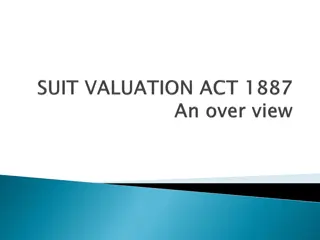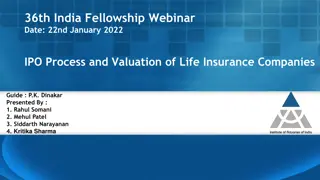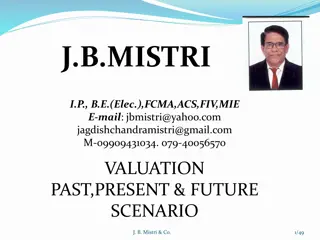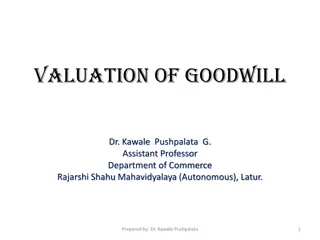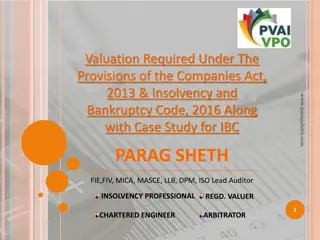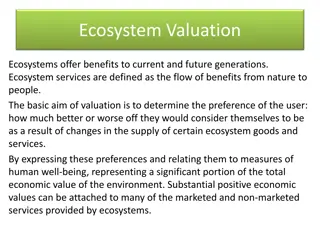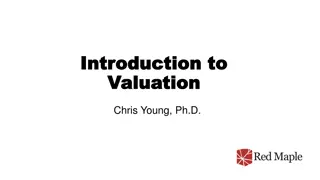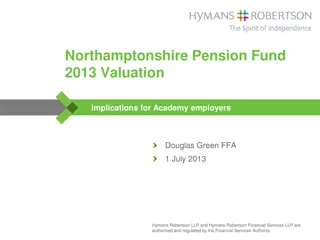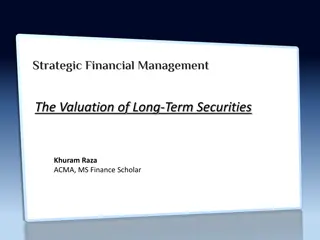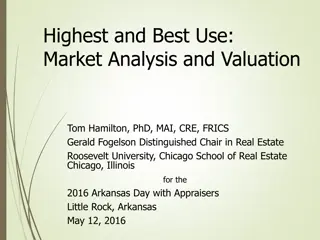
Valuation Requirements and Legal Provisions under Financial Acts
Explore valuation requirements under the Companies Act & Income Tax Act, along with legal provisions, approaches to valuation, and the role of registered valuers. Understand the methods, rules, and regulations for valuing shares and securities in compliance with financial laws.
Download Presentation

Please find below an Image/Link to download the presentation.
The content on the website is provided AS IS for your information and personal use only. It may not be sold, licensed, or shared on other websites without obtaining consent from the author. If you encounter any issues during the download, it is possible that the publisher has removed the file from their server.
You are allowed to download the files provided on this website for personal or commercial use, subject to the condition that they are used lawfully. All files are the property of their respective owners.
The content on the website is provided AS IS for your information and personal use only. It may not be sold, licensed, or shared on other websites without obtaining consent from the author.
E N D
Presentation Transcript
It is better to be approximately right, than precisely wrong -Warren Buffett
Valuation of Shares D N V & Co Chartered Accountants
Valuation Legal Provisions CompaniesAct, 2013 Income Tax Act, 1961 FEMA Regulations
Valuation Requirements under the Companies Act, 2013 Section 62 Further Issue of Share Capital Issue of sweat equity shares Issue of shares on a preferential basis. ESOP Buy Back Provisions with respect to Restructuring of Companies Power to compromise or make arrangements Purchase of minority shareholding
Valuation Requirements under Income Tax Act, 1961 Valuation of unquoted shares and securities Type of security Unquoted equity shares Unquoted equity shares Unquoted securities other than equity shares Applicable for all cases Transfer of Equity Shares Transaction In case of fresh issuance of shares Section 56 (2) (x) read with Rule 11UA(1)(c)(b) Section 56 (2) (viib) and (x) read with rule 11UA(1)(c)(c) Applicable section and rule Section 56 (2) (viib) read with Rule 11UA(2) Method prescribed for computation of FMV Discounted Cash Flow method (DCF) or book value method at the option of assesse Book Value method Method is not specified. Merchant Banker or chartered accountant Valuer Merchant Banker Merchant Banker or chartered accountant
Valuation Requirement under As per Regulation 11 of FEMA 20(R): Resident individual / Company Transfer / Fresh Issue of Shares Non Resident Resident individual Non Resident Transfer of Shares
Registered Valuer under Companies Act, 2013 Section 247 Valuation by Registered Valuers Eligibility Qualifications & Experience
Approaches to Valuation Asset / Cost Based Approach Market Based Approach Income Based Approach
Asset Based Approach The asset or cost approach to business valuation considers the underlying business assets in order to estimate the value of the overall business enterprise. Net asset Value Method Liquidation Value Method
Market Based Approach This approach uses the economic principle for competition which seeks estimate the value of a business in comparison to similar businesses whose value has been recently established by the market. Market Price Method Comparable Company Multiple (CCM) Method
Comparable Company Multiple (CCM) Method Identification of a Comparable Companies 1 Selection and Calculation of a Multiple 2 Comparing the Valuation Subject with the Comparable Company 3 Make Adjustments to the Valuation Subject & Comparable Companies 4 Revision of the Multiple 5 Determination of Enterprise Value 6
Income Based Approach This approach uses the economic principle of expectation to determine the value of a business. Direct Capitalization Methods - Single measure of business earnings Price Earning Capacity Value (PECV) Method Discounting Methods Stream of business earnings Discounted Cash Flow Method
DCF Value = PV of Free Cash Flows (FCF) + Terminal Value (TV) FCF to Equity (FCFE) FCF to the Firm (FCFF) Cost of Equity (Ke) using CAPM Weighted Average Cost of Capital (WACC) WACC = Ke (E/(D+E) + Kd(D/D+E) Ke = Rf + (Rm Rf) Terminal Value (TV) = Last year s FCF/ (Discount Rate TVg)
Concluding Remarks Managers and Investors alike must understand that accounting numbers are the beginning, not the end of business valuation. -Warren Buffet
References ICAI Study Material and other resources Various news websites, magazines and journals.

